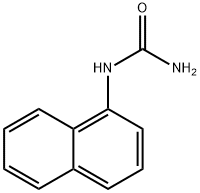1-NAPHTHYLUREA

- CAS No.
- 6950-84-1
- Chemical Name:
- 1-NAPHTHYLUREA
- Synonyms
- Nsc 65627;Ai3-61345;Naphthylurea;1-NAPHTHYLUREA;α-Naphthyl urea;Einecs 230-121-6;1-(1-Naphtyl)urea;ALPHA-NAPHTHYLUREA;Urea, 1-naphthalenyl-;1-(Naphthalen-1-yl)urea
- CBNumber:
- CB0224875
- Molecular Formula:
- C11H10N2O
- Molecular Weight:
- 186.21
- MOL File:
- 6950-84-1.mol
- MSDS File:
- SDS
- Modify Date:
- 2022/12/21 16:56:50
| Melting point | 219.5°C |
|---|---|
| Boiling point | 320.7°C (rough estimate) |
| Density | 1.1458 (rough estimate) |
| refractive index | 1.5300 (estimate) |
| storage temp. | 2-8°C |
| pka | 14.45±0.50(Predicted) |
| EPA Substance Registry System | Urea, 1-naphthalenyl- (6950-84-1) |
SAFETY
Risk and Safety Statements
| Symbol(GHS) |  GHS07 |
|---|---|
| Signal word | Warning |
| Hazard statements | H302-H315-H319-H335 |
| Precautionary statements | P261-P305+P351+P338 |
| RIDADR | UN 1652 6.1/ PGII |
| HazardClass | 6.1 |
| PackingGroup | II |
1-NAPHTHYLUREA Chemical Properties,Uses,Production
General Description
A gray solid. Insoluble in water and denser than water. Contact may irritate skin, eyes and mucous membranes. May be toxic by ingestion. Used to make other chemicals.
Air & Water Reactions
Insoluble in water.
Reactivity Profile
1-NAPHTHYLUREA is an amide. Amides/imides react with azo and diazo compounds to generate toxic gases. Flammable gases are formed by the reaction of organic amides/imides with strong reducing agents. Amides are very weak bases (weaker than water). Imides are less basic yet and in fact react with strong bases to form salts. That is, they can react as acids. Mixing amides with dehydrating agents such as P2O5 or SOCl2 generates the corresponding nitrile. The combustion of these compounds generates mixed oxides of nitrogen (NOx).
Health Hazard
TOXIC; inhalation, ingestion or skin contact with material may cause severe injury or death. Contact with molten substance may cause severe burns to skin and eyes. Avoid any skin contact. Effects of contact or inhalation may be delayed. Fire may produce irritating, corrosive and/or toxic gases. Runoff from fire control or dilution water may be corrosive and/or toxic and cause pollution.
Fire Hazard
Combustible material: may burn but does not ignite readily. When heated, vapors may form explosive mixtures with air: indoors, outdoors and sewers explosion hazards. Contact with metals may evolve flammable hydrogen gas. Containers may explode when heated. Runoff may pollute waterways. Substance may be transported in a molten form.
Purification Methods
Crystallise the urea from EtOH (m 213-214o also 215o). [Beilstein 12 H 1238, 12 IV 3076.]
1-NAPHTHYLUREA Preparation Products And Raw materials
| Supplier | Tel | Country | ProdList | Advantage | Inquiry |
|---|---|---|---|---|---|
| Hangzhou FandaChem Co.,Ltd. | 008657128800458; +8615858145714 | China | 9337 | 55 | Inquiry |
| Dayang Chem (Hangzhou) Co.,Ltd. | 571-88938639 +8617705817739 | China | 52861 | 58 | Inquiry |
| GIHI CHEMICALS CO.,LIMITED | +8618058761490 | China | 49999 | 58 | Inquiry |
| Amadis Chemical Company Limited | 571-89925085 | China | 131980 | 58 | Inquiry |
| Shaanxi Dideu Newmaterial Co., Ltd. | 029-63373950 15353716720 | China | 10011 | 58 | Inquiry |
| Beijing Haite lesk Technology Co., Ltd | 15210893940; 15116916250 | China | 7327 | 58 | Inquiry |
| Shanghai Raise Chemical Technology Co.,Ltd | 15026594951 | China | 3375 | 55 | Inquiry |
| WEITIXIHAUGONG | 0371-53370800 18037197114 | China | 10007 | 58 | Inquiry |
| Bide Pharmatech Ltd. | 400-1647117 15221909166 | China | 63720 | 58 | Inquiry |
| Changzhou Qianai Biotechnology Co., Ltd | 0519-15240519135 13961152745 | China | 5293 | 58 | Inquiry |
6950-84-1(1-NAPHTHYLUREA)Related Search:
1of2
chevron_right




